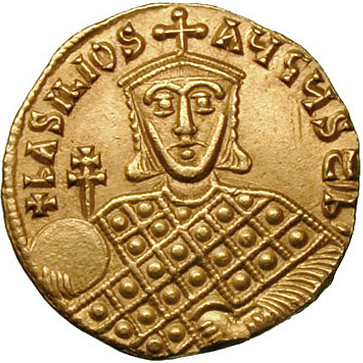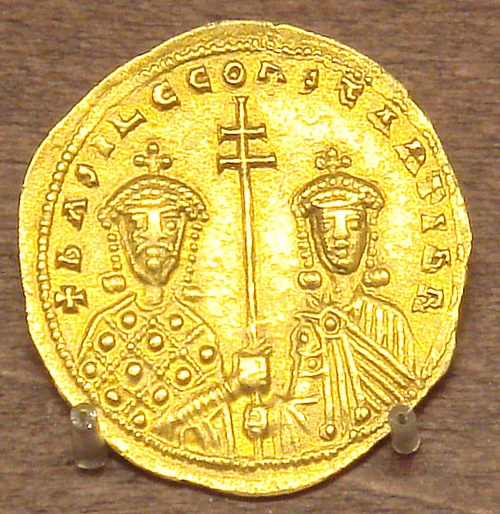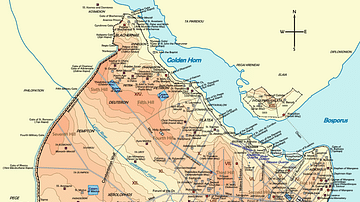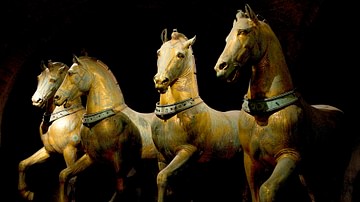
The coinage of the Byzantine Empire continued that of its more ancient predecessors and functioned as a convenient method of payment for goods and services, especially to soldiers and officials, and as a means for people to pay their taxes. Coins also continued to be the best way for a ruler to spread their image and remind their people who they owed their allegiance to. The star of the Byzantine purse was undoubtedly the gold solidus or nomisma. Introduced by Constantine I in the 4th century CE, it would reign supreme as the currency standard for 700 years, eventually to be replaced by the electrum hyperpyron from the 12th century CE.
The Nomisma as Standard
Every Byzantine emperor minted their own coins, from either Constantinople, the capital, or in mints in major provinces such as Italy (Ravenna), Sicily (Syracuse), Anatolia (Antioch), and North Africa (Carthage and Alexandria). As in the ancient world, the value of coins in Byzantium depended on their weight and the purity of the metal used to produce them. The main coin of the Byzantine empire for 700 years was the solid gold nomisma or solidus in Latin. On its introduction in the East in 312 CE by emperor Constantine I (r. 306-337 CE), 72 nomismata were equal to one pound of gold. Thus, each example weighed 4.4 grams of pure gold and measured between 21 and 22 mm in diameter. The first versions carried a portrait of Constantine on the obverse (front) and Roman army standards on the reverse side. Further currency reforms were carried out by Anastasius I (r. 491-518 CE) whose reign actually marks the beginning of Byzantine coinage proper for numismatists.
Such was the nomisma's longevity and reliability - Basil II was still minting them in the 1020s CE - that the worth of all other lesser-value coins made of gold, silver, or copper was measured against it. For example, the gold semissis was equal to half a nomisma, while three gold tremissis coins were worth one nomisma. Both of these coins would still be in circulation in the late 9th century CE.
The most common silver coin was the miliaresion, introduced in 720 CE, twelve of which were worth one nomisma. The most common copper coin was the large follis, introduced by Anastasios I (r. 491-518 CE) to improve the poor quality coins of previous emperors, which was worth very little but was useful for small transactions: 24 folles were equal to one miliaresion while a whopping 288 were required in exchange for a single nomisma. In terms of actual value, a labourer would have earned between five and twelve folles a day while a middle-ranking official earned some 1000 nomismata per year. One nomisma could have bought you a pig, three were needed for a donkey, fifteen was the price of a camel, and a slave with a few skills would have set you back 30 gold coins - a purchase to be made with care, clearly. Aristocrats measured their wealth in the thousands of nomismata while in the rare cases where a field army's four-year treasure chest was stolen by the enemy, such as the Bulgars in 809 CE or the Arabs in 811 CE, we know that it consisted of 80-90,000 nomismata - enough to make a tax collector's eyes water.
Devaluations
The nomisma did face brief challenges to its dominance. In the 6th and 7th century CE a less pure gold coin (22 carats as opposed to 24) was minted but did not last. A more serious challenger came in the mid-10th century CE in the form of Nikephoros II Phokas' (r. 963-969 CE) attempt to save even more gold and produce more coins. He minted a gold coin, the tetarteron, which was not only 22 carats instead of pure gold but also with one-twelfth less weight than the nomisma. In the first half of the 11th century CE, Constantine VIII (r. 1025-1028 CE) and Michael IV (r. 1034-1041 CE) both nibbled at the nomisma itself and added 5% silver to eke out more bang for their buck. This was the beginning of a slippery slope towards a much-devalued currency.
It is debatable if emperors understood or not the long-term economic consequences of undermining their own currency, but they could not resist consistently tinkering with the gold content of their coins, reducing it when the state coffers were low and endangering confidence in the coin. Perhaps the practical necessity of the moment and the need to pay mercenary soldiers to defend the empire or make up for tax shortfalls when plagues hit the population took precedence over economic theory. As a consequence, over the whole of the 11th century CE, the gold content of the nomisma gradually went down in stages from 20 to 18 to 16 to 12 and ended up around 8 carats during the reign of Nikephoros III Votaneiates (r. 1078-1081 CE).
In the 10th century CE there were, in fact, six different versions of the nomisma in circulation and international merchants even began to favour Arab gold dinars. The state of the premier coin of the realm became so bad and prices were rising so quickly that reform was urgently needed. Consequently, Emperor Alexios I Komnenos (r. 1081-1118 CE) minted a new coin c. 1092 CE, the hyperpyron (meaning “highly refined”), which became the new standard, even if it was actually made from electrum (an alloy of gold and silver) and worth only a third of the nomisma. Alexios had sorted out the currency confusion of nobody knowing quite what the equivalents of all the coins in circulation were, but he also, rather astutely, managed to quadruple tax rates in the process. The hyperpyron did take a few decades to take off and, like the nomisma, it occasionally suffered a debasement, notably during the reign of Michael VIII (r. 1259-1282 CE), but it would survive until the fall of the empire in the 15th century CE.
Imagery
Coins were spread far and wide thanks to merchants and travellers so they could be used to good effect as a useful means of propaganda by rulers eager to extend their power and fame into every corner of the empire and to its neighbours. Portraits were conventionalised and did not approach the realism of, say, ancient Hellenistic or Roman coins. They usually show the person front on rather than in profile and holding a cross, sword, or sceptre. The name is helpfully written, too, which is just as well given the often poor likenesses of the time.
Not only could the emperor or empress put their own face on the front of the coin - Empress Irene (r. 797-802 CE) went one better and put herself on both sides - but they could reinforce their message with other symbols of imperial power on the back. Short legends were first written in Latin, then in Latin and Greek, and then wholly in Greek from the 7th century CE. Constantine I often used the Tyche of Constantinople on the reverse of his coins. A symbol of good fortune, she sits on a throne, wears a crown with battlements and holds a cornucopia. The cross of Christianity and the Christogram became a favourite choice for many subsequent emperors. The Virgin or saints frequently appear while the coins of Alexander (r. 912-913 CE) have John the Baptist being crowned by the emperor.
Justinian II (r. 685-695 CE) had been the first emperor to show Jesus Christ on coins c. 691 CE along with the legend rex regnantium (“King of kings”). There were two versions of Jesus, one with a beard and one without, and they are similar to surviving mosaic portraits. Perhaps it is no coincidence that this pious emperor insisted that the Arab caliphate pay their tribute with these coins (which they refused and, in response to the affront, successfully invaded Anatolia to boot). By the mid-9th century CE Christ was regularly shown on the obverse of coins with the legend “Jesus Christ, King of those who rule.” The reverse sides of these coins showed the emperor being crowned by Christ, the Virgin, or a particular saint, and so reminded people that he or she was God's representative on earth.
Coin portraits were also used for political endorsements, especially when emperors had selected their chosen heir and wished to avoid a messy succession dispute after their own death. The child was often crowned as co-emperor and shown as such on coins, side by side with their parent or on the reverse side, sometimes with a sibling alongside.
Circulation
For most people, the copper and silver denominations of coins would have been the only ones they handled on a daily basis. Those lucky enough to have a shiny gold nomisma in their palm probably did not keep it for very long as one of the main reasons for the state to mint coins in the first place, besides to pay soldiers and officials, was to more easily collect taxes. There were basic and ever-present taxes on land and persons/households, besides any other ingenious excuse the tax authority could come up with, such as a levy on any slave imported from a particular region. Further, all taxes had to be paid in gold coins, which was probably why the state was so vigorous in ensuring their quality.
In fact, the minting of nomisma coins was so carefully monitored and their gold content checked so scrupulously by the state that their reliability ensured even foreign states accepted and used them. The 6th-century CE merchant Cosmas Indicopleustes noted,
…every nation conducts its commerce with their nomisma, which is acceptable in every place from one end of the earth to the other…In no other nation does such a thing exist.
(Herrin, 322)
The scarcity of foreign coins excavated at Constantinople is further evidence that only one coinage dominated the imperial economy. The Arab caliphate, getting over its initial dislike of the coin, was one notable user of the nomisma, where it was known as the bezant. Usually preferring it to minting their own gold coinage, they did sometimes produce their own coins which imitated, right down to the legends, those of Byzantium. Viking kings were also partial to Byzantine gold, and many coin hoards have been found across Scandinavia and northern Europe. Byzantine coins have turned up in such far-flung places as Russia, Persia, and Sri Lanka. From the 4th until the 11th century CE, and probably beyond, the nomisma was, then, the international coin of the day, and it has rightly earned from historians the unofficial title of the “dollar of the Middle Ages.”












![The World of the Crusades: A Daily Life Encyclopedia [2 volumes] (Daily Life Encyclopedias)](https://m.media-amazon.com/images/I/51Uo59piPeL._SL160_.jpg)